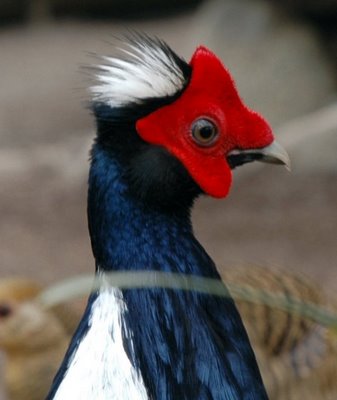The weather at Glacier Bay National Park (Crystal Ice Chime) remains temperate:
Elevation : 33 feet / 10 meters
Temperature : 32 Fahrenheit / 0 Celsius
Conditions : Mostly Cloudy
Humidity : 80%
Wind : 6 mph / 9 km/h / 2.6 m/s from the Southeast
Pressure : 29.70 inches / 1006 hPa
Windchill : 26 Fahrenheit / -3 Celsius
Visibility : 10.0 miles / 16.1 kilometers
UV : 0 out of 16
Clouds : Mostly Cloudy 3500 feet / 1066 meters above ground level
This Blog is created to stress the importance of Peace as an environmental directive. “I never give them hell. I just tell the truth and they think it’s hell.” – Harry Truman (I receive no compensation from any entry on this blog.)
Monday, January 22, 2007
Sunday, January 21, 2007
A moral conscience is a person's best survival tool
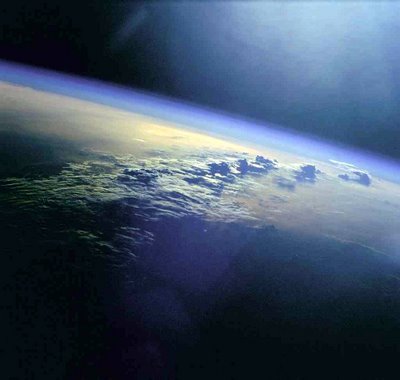
How hot will Earth get?
It depends entirely on how abusive humans are of it's biota, each other and the will to survive over the concept of economic viability.
We are on this satellite of Sol together. We either adapt to it's limitations and our own or we won't survive.
Somewhere in the background of all this is the concept that as Climate Change unveils itself enough people will die that will allow Earth's tropospheric carbon dioxide to decrease resulting in a return of Earth's benevolent balance.
I don't find any morality in that. None. And IF the First World is seeing themselves as the survivors due to their technology? Think again.
Violent storms cause deaths and chaos in Europe (click on)
Hurricane-force winds that struck Germany have killed at least three people and further deaths have been reported in the Netherlands and France.
Falling trees killed two men in Great Britain. Richard Heard, 54, one of the two, died on his way to work as the managing director of Birmingham Airport when a tree branch crashed into his windscreen on the B4373 near Bridgnorth, Shropshire.
Hurricane-force winds blamed for 47 deaths across Europe (click on)
By Melissa Eddy
ASSOCIATED PRESS
BERLIN - Workers across Europe hauled away fallen trees and repaired power lines yesterday after the deadliest storm to strike the continent in eight years killed at least 47 people and caused hundreds of millions of dollars in damage.
Trains started rolling again after a near-total shutdown during Thursday night's hurricane-force winds. Airports from London to Frankfurt reported some delays and cancellations, but were returning to normal.
The disruption hit countries from Britain to Ukraine, where the flow of Russian oil through a key pipeline to Europe was temporarily halted after power to a pumping station was knocked out.
The storm knocked out electricity to more than 1 million homes in the Czech Republic, which was hit by winds of up to 112 mph. Ladislav Kriz, spokesman for the main Czech CEZ utility, said last night that power was restored to most of the homes affected by the storm, although about 170,000 customers were still without electricity.
A million households in Germany and tens of thousands of homes in Poland and Austria also lost power.
EDF Energy in Britain said yesterday it had restored power to more than 90 percent of the 350,000 customers cut off the night before, while Scottish Power said about 30,000 of its customers remained without electricity.
Stormy weather had been predicted this year for parts of Europe, with researchers saying unusually high temperatures in the North Atlantic would allow winds to accumulate more moisture and create a surge in energy.
The storm killed 14 people in Britain, 12 in Germany, six each in the Netherlands and Poland, four in the Czech Republic, three in France and two in Belgium.
It was the highest death toll from a European storm since 1999, when gales downed trees and driving snow brought on avalanches, killing more than 120 people.
Germany's GDV insurance association put insured losses at $1.3 billion in that country alone, and the Union of Insurers in the Netherlands estimated damage there at $207 million.
New ice storm moves across central southern USA (click on)
...The latest winter blast has led to reports of at least 74 deaths in nine states in the past week, including 25 in Oklahoma, 14 in Missouri and 12 in Texas. Many of the deaths were caused by car wrecks or carbon monoxide poisoning from portable generators, the AP reports....

Earth is a magnificent and complex planet. But, don't underestimate the potency of human impact on it.
To date, the production of carbon dioxide by humans has not abated. The rising temperatures of Earth and it's oceans have not abated. What makes anyone believe there will be a reversal of that trend? The historical record? That is null and void. This is a unique event on Earth. There has never been this type of consumerism or population before on this planet. Never.
The historical record is interesting from one perspective. That it is record setting.
Carbon dioxide level highest in 650,000 years (click on)
...Analysis of carbon dioxide in the ancient Antarctic ice showed that at no point in the past 650,000 years did levels approach today's carbon dioxide concentrations of around 380 parts per million (ppm). The Intergovernmental Panel on Climate Change (IPCC) projects that atmospheric carbon dioxide levels could reach 450-550 ppm by 2050, possibly resulting in higher temperatures and rising sea levels (see "Ocean levels rising twice as fast"). There is fear that climate change could create a class of environmental refugees displaced from their homes by rising oceans, increasingly catastrophic weather, and expanding deserts.
THE SADDEST REALITY that is revealed in the historical record is the fact that humans, as they exist today, have only existed on Earth a very short time.
The First Humans (click on)
Of all the continents Africa was probably the first to be home to humankind. In his book The Descent Of Man (1871), the famous naturalist, Charles Darwin, called Africa “the cradle of humankind.” Darwin made this comment to support his theory of evolution in Origin of the Species, which he published in 1859. Since then research in eastern and southern Africa shows our ancient ancestors lived as far back as 5 to 10 million years ago.
AND OF THAT 5 to 10 million years ago, Homo sapiens have only existed in the past 200,000 years. The current state of human has never experienced the high levels of carbon dioxide reported at a high of 650,000 years ago.
Homo sapiens: Earliest forms of our own species (click on)
"The surviving physical evidence, from skulls such as these, suggests that the transition from Homo erectus to Homo sapiens, the earliest forms of our own species, occurred approximately 300,000 to 400,000 years ago."

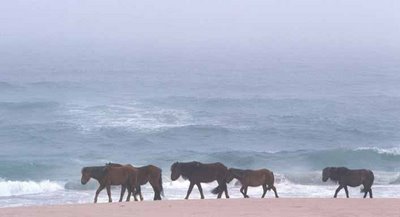
What is the species adapation range for humans?
What makes anyone believe that morally 'only the strong' are supposed to survive?
Where does a government find the audacity to pass judgement on others as 'worthy' of survival when they are deemed to have the ability to survive a heating planet due to their wealth and technology?
Where does a country like the USA find morality in satiating their creature comforts over negligence of the very biota of Earth that has been offered as a place to live, breath and have life happen?
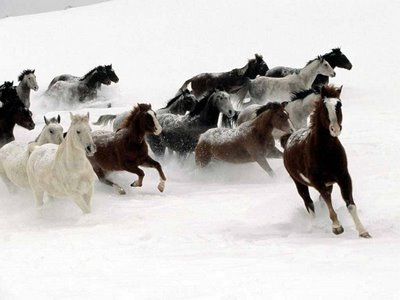
When conditions on Earth become increasingly difficult to find comfort for survival the result will be extinction no matter how genetic diverse a species might be to facilitate the extremes before it's demise. The 'gene pool' of a species will search without end for adaptation/mutation, but, if the extremes are too extreme the diversity, God given if you like, will fail.
For those thinking they are do for a miracle by their savior long about now, I remind them that they were given a biological place to live and they failed at it.

Spatial patterns of demography and genetic processes across the species' range: Null hypotheses for landscape conservation genetics

These horses can represent the 'core' of the concept of 'species range' or 'landscape conservation.'
Spatial patterns of migration. Genetic migration. The range in which a species' genetics allows it to adapt to changes in the environment of which it survives.
The light colored horses are the 'core' of the survival species while the grays are a 'range' of that species near the core; while the dark horses are the peripheral genetic variability. They are the survivors when all else fails for the core of the genetic composition for this species.
But.
What occurs when even the dark colored survivors are faced with elements in their survival range that compromise their genetic toughness?
More than likely, extinction.

Abstract
Compared with populations near the core of a species' range, edge populations tend to be characterized by low density and high temporal variation. Based on empirical studies quantifying this pattern, we show that effective population size (N e)could be 2 to 30 times greater near the core of the species' range than near the edge of the range.
Hence, the rate of genetic drift may be 2 to 30 times greater near the edge of the range. Despite these strong spatial patterns in N e, empirical findings indicate that peripheral populations sometimes have less but sometimes have more genetic diversity than core populations.
Our analysis indicates that this variation can be explained by uncertainty in spatial patterns of migration rates. Nevertheless, our analysis:(1) provides a framework or null hypothesis for empirically assessing how spatial patterns of migration or selection influence large-scales patial patterns of genetic diversity, (2)highlights the potential importance of contemporary processes, such as spatial patterns in N e (cf. historicalphenomena, such as range expansion) in the development and maintenance of large-scales patial patterns in genetic diversity, and (3) provides new context for understanding the conservation value and vulnerability of peripheral populations. The conservation of ecological/evolutionary processes requires understanding large scale spatial patterns of demographic and genetic processes such as that described here.

But.
Could The Peppered Moth ever turn green?
No.
A clear illustration of genetic diversity with limits. In a world where all tree trunks were green, The Peppered Moth would succumb to the appetites of birds. Their camouflage would not work to hide them from predation.
Genetic diversity in the way biodiversity seeks to clarify species richness/diversity is limited.

Consider 'The Peppered Moth'
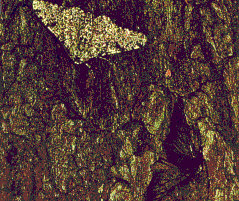
The Peppered Moth is argued to bring an illustration to evolutionary biology. I suppose. But, I personally don't feel there is that much evolution in this so much as frank and sustainable biology. Very simply put, The Peppered Moth had what it takes to survive. To understand the entire reality of this moth, Wikipedia has an interesting entry including the bird that sought as satiation in appetite the demise of the moth.
In it's genetic variability, The Peppered Moth survived the human created stress of pollution on tree trunks that would have destroyed them. Interesting to realize a moth could actually be so agile in it's genetic imprint to survive a manmade hurdle of their survival.

The definition of 'species' vs. 'biodiversity'
The concept of 'biodiversity' is a profound departure from extinction. To define the viability of life on Earth as species richness is to limit the ability of life to exist. In defining species as a particular set of descriptors is to depart from the reality of Earth's biotic nature.
Yet for as limber as biodiversity is in definition, when one regards it's potential, is it realistic to expect the very word to define the potential for everlasting adaptation of life FOR Earth?
I think not.
Sometimes scientists lock themselves into a reality of definitions in order to satisfy the 'idea' of laws and governance of their science. It is excellance they seek in providing exacting definitions to scientific language. In this exacting language some have found a 'safe haven' to provide for tolerance to extremes such as the emergency we are facing on Earth with Human Induced Global Warming. It is that 'idea' of tolerance of biotic demise with the lone survival of humans on Earth that I intend to challenge. From the beginning of my advocacy, now a full five years of continuous appeal, I have stated humans will find this episode of Earth's warming less and less tolerable then they expect with the very potential of exceeding the 'limits' of human survival.
Yet for as limber as biodiversity is in definition, when one regards it's potential, is it realistic to expect the very word to define the potential for everlasting adaptation of life FOR Earth?
I think not.
Sometimes scientists lock themselves into a reality of definitions in order to satisfy the 'idea' of laws and governance of their science. It is excellance they seek in providing exacting definitions to scientific language. In this exacting language some have found a 'safe haven' to provide for tolerance to extremes such as the emergency we are facing on Earth with Human Induced Global Warming. It is that 'idea' of tolerance of biotic demise with the lone survival of humans on Earth that I intend to challenge. From the beginning of my advocacy, now a full five years of continuous appeal, I have stated humans will find this episode of Earth's warming less and less tolerable then they expect with the very potential of exceeding the 'limits' of human survival.

In the wild/natural habitat, their instincts are keen, they are 'equipped' to take care of themselves.
In confinement those instincts are blunted by a different reality. It is questionably cruel to put such magnificent creatures in captivity. I am not going to go into the morality of zoos, they exist and quite frankly without them we would be left with taxadermy to educate ourselves about Earth and it's species diversity. It's silly to assume that a human fascination with animals kept close to society in zoos is wrong. It's a statement about our humanity, our compassion, our desire to be among all of what is life. We have come to appreciate Earth and it's wonderment because of humanized institutions such as zoos. I believe it is healthy and important to maintain high morals in regard to the other life we include living among us and with us, close to home. It's admirable for an intelligent species such as human beings, to consider other species as important to our lives as perhaps we become to them when contact is made.
What is vitally important in realizing how poorly humans have managed their compatibility with the planet that supports life, zoos are not a Noah's Ark. It would be wrong to consider such a reality in the face of prudent economics resulting in responsible energy sources and transportation.
If one is of religious conviction then realize Earth is the place God has made a stand with biological reality. If Polar Bears are to be wild in the way of the Lord; then to contain them and change them in order to protect them while humans rampage around disregarding the pure nature of an animal's reality, is to disregard God's will.

Ever see a hairless polar bear?
"Polar Bear" by Queen
In the bright shop window sits the polar bear
Makes the children's eyes light up to see him there
Amongst the tinsel he gives everyone a smile
To see him as you'd see a star
Love him from where you are
He's not for, not for, not for sale
Past an open window walks the pretty girl
Does she see me at her feet it's hard to tell
But if I ask her she might turn her smile away
To see her as I'd see a star
Love her from where you are
She's not for, not for, not for sale
I guess I'll learn to look
Without a grasping hand
Minor contentment wears a smile
I love her from where I lie
He's not for,not for,not for sale
Not for sale
Makes the children's eyes light up to see him there
Amongst the tinsel he gives everyone a smile
To see him as you'd see a star
Love him from where you are
He's not for, not for, not for sale
Past an open window walks the pretty girl
Does she see me at her feet it's hard to tell
But if I ask her she might turn her smile away
To see her as I'd see a star
Love her from where you are
She's not for, not for, not for sale
I guess I'll learn to look
Without a grasping hand
Minor contentment wears a smile
I love her from where I lie
He's not for,not for,not for sale
Not for sale
Saturday, January 20, 2007
Trying to decide what to discuss tonight...
Odd Rooster isn't it? I think it is Japanese species.
My first instinct is to do this tomorrow night. There is some misunderstanding to species demise which I need dispel. It goes like this, where everyone is stating 'Global warming is no big deal and humans will survive, the real concern is species demise other than human. The catch is that IF these 'lower' species had more time to adapt Earth would be doing just fine even with the higher temperature climate." That is incorrect yet it is a widely held belief. I think that is what needs the most attention this week. The topic has been set aside so I could attempt to save human lives exposed to war. Go figure, huh? Trading immediate survival for the later discussion of Earth and it's ability to support life at 98.6 Fahrenheit.
I'd like to touch briefly on Iraq. The war is over. The USA is out of that country. That seems evident from all aspects. The Democrats did a great job. A presence in a majority has scared sense into a corrupt and criminal White House. The 'show' going on in Iraq now with the USA forces and Bush's 'face saving' maneuvers is just to provide a 'rational' for leaving as if the USA has finally declared "Mission Accomplished."
The presidential field for 2008 seems to be wide open.
Not really.
I believe men like Senator Brownback are using this 'opportunity' to appear far more worthy of his Senate seat than his constituency can imagine. He is an example of a 'fading' Republican. He has cast his 'image' and 'vote' so much in the Bush shadow that he is forced to take up the 'attempt' for a presidential nomination to just reestablish his legitimacy for his Senate seat. This past election highly conservative Senators found their winning margin to be far less than they are comfortable with and for that reason they are feeling insecure in their political 'careers.' I didn't now SERVING this country was a career to begin with it, but, to some it is. Orin Hatch really should go away already. Love Senator Bird, though. He held the constitution in his heart during this very trying period in the USA as he maneuvered through very tortures waters. Love the guy. When I heard him speak, I heard Thomas Jefferson and Benjamin Franklin from beyond the grave.
But, these men that are running like Brownback, are running against a voting record they want to recreate. They'll even say that Mr. Bush left Iraq prematurely and lead people to believe we will be back there in a sometime in the near future, because of the majority Democrats now. As a matter of fact to insure the Neocons and conservative Christians are 'in tow' someone like Brownback will allude to a return to those directives IF of course there is a return to the majority of Republicans as in the 'good days' of Bush.
Back Sunday at 8:30 PM.
Peace
Shalom
Northern Hemisphere Temperatures Mild in December 2006

As of early January 2007, the 2006-2007 Northern Hemisphere winter was proving to be a mild one in terms of temperatures. In North America, significant snows had yet to fall in many of the usual places, including most of New England. In the United States’ capital, the city’s famous cherry trees welcomed the new year with blooms—a show they don’t normally put on until spring. In Europe, World Cup ski events had to be moved, postponed, or canceled because of lack of snow in the mountains.
The unusually warm temperatures are apparent in this image, which shows the December 2006 land surface temperature compared to the average December temperatures from 2000-2005. (Land surface temperatures are how hot or cool the land surface would feel to the touch. It is different from the air temperature, which is what weather stations usually measure.) Based on data from the Moderate Resolution Imaging Spectroradiometer (MODIS) on NASA’s Terra satellite, the image shows places where daytime land surface temperatures were above the five-year average in red, places where it was below the average in blue, and places near the average as white. Dramatic swaths of red paint most of the Northern Hemisphere. In parts of Central Canada, the North American Great Lakes region, eastern and northern Europe, and central Siberia, the land surface was up to 10 degrees Celsius warmer than in the recent past. This pattern of unusual warmth across both North America and Eurasia is different from conditions observed by MODIS in the previous winter; in January 2006, North America was warmer than average, while Eurasia was chillier than average.
A few notable colder-than-normal spots stand out in the image. In the central United States, several whopping snow storms laid down a chilly blanket over the land surface in late December, creating a blue ribbon of cooler-than-normal temperatures that stretched northeastward from Colorado to Lake Michigan. Both Russia’s Far East (upper right) and Southwest Asia were cooler than average, as well. Persistent heavy rains in East Africa in late 2005 may be responsible for that region’s cooler-than-average condition in December.
Since (Northern Hemisphere) fall 2006, an El Niño had been brewing in the Pacific Ocean, making ocean surface temperatures in the eastern Pacific warmer than average and those in the Western Pacific cooler than average. During moderate to strong El Niño events, winters in the United States are often mild, with above-average precipitation in the country’s southwest and southeast.
NASA image by Jesse Allen, based on data from Zhengming Wan, MODIS Land Surface Temperature Group, Institute for Computational Earth System Science, University of California, Santa Barbara.

Ayles Ice Shelf, Ellesmere Island
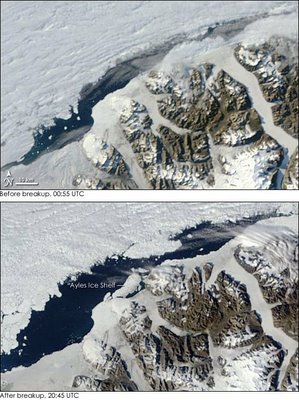
On August 13, 2005, the remote Ayles Ice Shelf on Ellesmere Island in northern Canada broke free and began drifting out to sea. The ice shelf was roughly 66 square kilometers (25 square miles), slightly larger than Manhattan, New York, or 11,000 football fields. According to The New York Times and the Canadian Broadcasting Corporation (CBC), the ice shelf broke free in less than an hour. Laurie Weir of the Canadian Ice Service first detected the ice shelf break when reviewing satellite images of the island.
The Moderate Resolution Imaging Spectroradiometer (MODIS) on NASA’s Terra satellite captured these images of the ice shelf on August 13, 2005. The top image shows the area before the ice shelf breakup, and the bottom image shows the area after the breakup. In the second image, the ice shelf has broken away from the island and is moving in a counter-clockwise direction out to sea. In the second image, the edge of the shelf still shows where it was connected to the island, but smaller pieces of ice also litter the water between the island and the newly broken-off shelf.
Unlike ice shelves in Antarctica and Greenland that are fed by massive glaciers, the Ayles Ice Shelf was comprised of compacted, thickened sea ice. Centuries of persistent winds blowing toward land had compressed the ice into a virtually permanent ice plate attached to the north coast of Ellesmere Island. The years 2002 through 2005 were unusually warm in the Arctic, and 2005 was marked by a strong decline in Arctic sea ice. Writing on his Website, Luke Copland, director of the University of Ottawa’s Laboratory for Cryospheric Research, said, “This [breakup] reduced the remaining ice shelves there from 6 to 5, and continues a trend of dramatic loss of these ice shelves over the past century. Since 1900, approximately 90% of the Ellesmere Island ice shelves have calved and floated away. This is a one-way process as there is insufficient new ice formation to replace the ice that has been lost. The Ayles calving event was the largest in at least the last 25 years....” In the The New York Times, Copland said that attributing the shelf collapse to human-caused global warming would be premature, although the shelf’s quick demise was a sign that warming temperatures are producing rapid changes in the Arctic.
Further Reading:
Environment Canada: The Calving of the Ayles Ice Shelf. Accessed January 5, 2007.
University of Ottowa Laboratory for Cryospheric Research: Ayles Ice Shelf Breaks in the Canadian Arctic. Accessed January 5, 2007.
NASA Earth Observatory: Larsen B Ice Shelf Collapse. Accessed January 5, 2007.
NASA Earth Observatory: Ward Hunt Ice Shelf. Accessed January 5, 2007.
NASA image courtesy Jeff Schmaltz, MODIS Rapid Response Team, Goddard Space Flight Center

Ayles Ice Shelf, Ellesmere Island

On August 13, 2005, the Ayles Ice Shelf on Ellesmere Island in northern Canada broke away from the island and floated out to sea. According to news reports, the break took less than an hour, and Luke Copland, director of the University of Ottawa’s Laboratory for Cryospheric Research, described the break as evidence of the Arctic’s rapid response to warming temperatures.
The Advanced Spaceborne Thermal Emission and Reflection Radiometer (ASTER) on NASA’s Terra satellite observed the area before and after the ice shelf breakup. The top image, acquired on August 14, 2002, shows the area three years before the ice shelf broke free. In this image, melt ponds mark the surface of the shelf. The parallel configuration of the melt ponds suggests that the ice had been compressed like an accordion into ridges against the coastline. Beyond the ice shelf is ice known as fast ice—sea ice that holds fast to a coastline or ice shelf. Farther out to sea is loose sea ice, floating on the ocean’s surface in plates of varying size.
The bottom image shows the area on July 1, 2006, almost a year after the ice shelf broke free. In this image, what remains of the ice shelf is also littered with melt ponds, but without the parallel pond configuration. Beyond the shelf remnant is compressed sea ice, which makes a blue-and-white mosaic. At image left, snow or glaciers on Ellesmere Island appear smoothly white against the bare, brown ground.

Subscribe to:
Posts (Atom)


